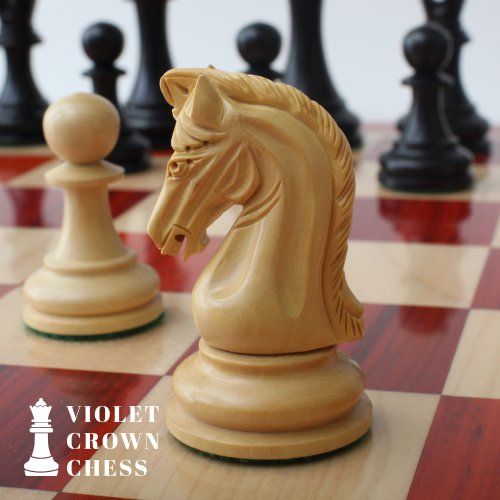French Régence Chess Set, ca. 1780-1820
A French chess set made in the "Régence" pattern, named after the famous Café de la Régence in Paris. The pieces are turned from boxwood or fruitwood, one side stained in dark brown, most likely made in the late 18th or early 19th century in the St. Claude region (Jura) in France. King size is 80 mm. The Kings and Queens with urn shaped bases and circular collars on a slim stem, the Kings with a finely carved "Tulip Crown", typical for this type of set, the Queen with bulb top finials. The Rooks as full towers on a circular pedestal with four crenellations on top. The Knights and Bishops with spherical bases on a small circular pedestal. The Knights, extremely tall and just a tad shorter than the Kings, as beautifully carved horses' heads with manes on the left side and an impressive shellac lacquer finish. The Bishops with bulb top finials and circular collars, parts of which were traditionally cut out, allegedly to symbolize the waning influence of the clergy due to the Enlightenment (cf. Kloprogge, Chessmen - Art and History, p. 101). The Pawns with slim stems on broad bases and bulb top finials.
The Café de la Régence was the center of chess in ancient Paris. The café was founded in 1681 as one of the first coffee houses in Paris under the name Café de la Place du Palais-Royal. It was located between the Rue Saint-Honoré and the Place du Palais-Royal. It was renamed Café de la Régence in 1715 at the earliest, as the new name referred to the era of the regency (La Régence), which lasted from 1715 to 1723, when the Duke of Orléans ruled over the young king Louis XV, who was still a minor. The Café de la Régence attracted players like Voltaire, Rousseau, Stamma and Philidor, Ben Franklin, Robespierre, Napoleon, Harrwitz and Morphy.
The setup shown on the last pictures is corresponding to the set and period, a game from 1790 by François André Danican Philidor.















